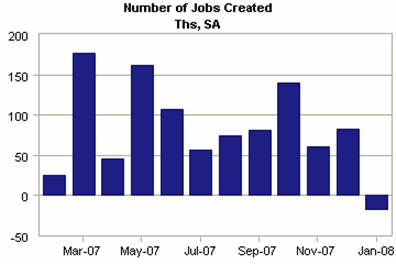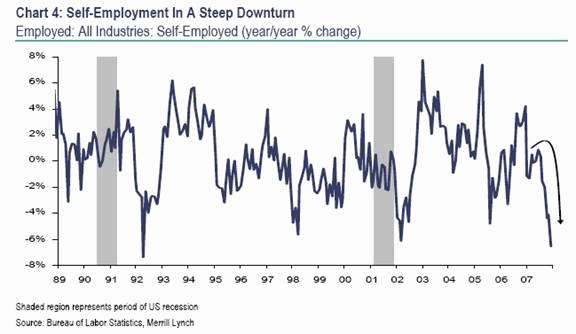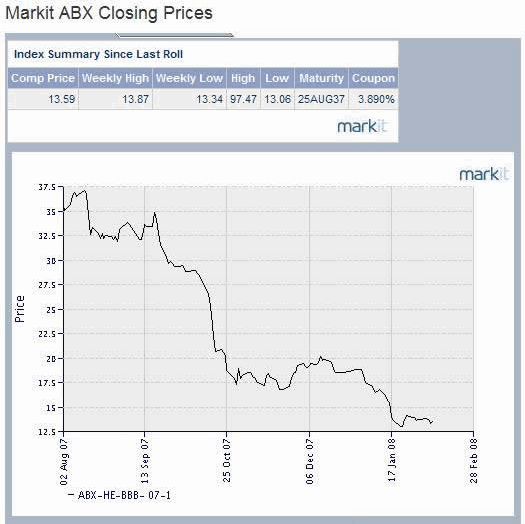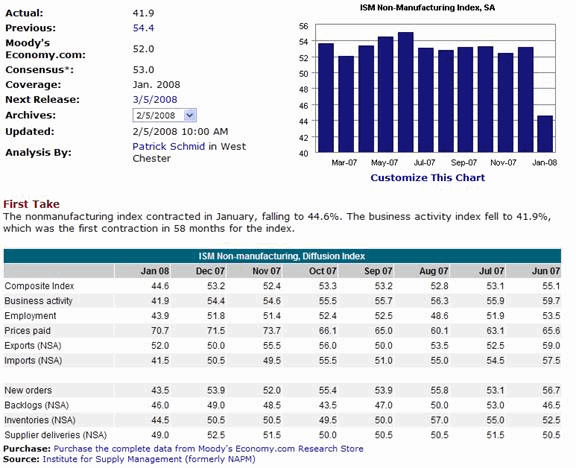| Consumers, Credit, and Complications |
| By John Mauldin |
Published
02/10/2008
|
Stocks , Options , Futures , Currency
|
Unrated
|
|
|
|
Consumers, Credit, and Complications
The evidence continues to mount that the US is in a recession. In this week's letter, we will look at the blind spot in the unemployment statistics, the continuing meltdown in the credit markets, and the simply awful service sector implosion in the ISM data, and then add a few thoughts on the housing market. There is a lot of data to cover, so this week's letter should be particularly interesting. The letter will print longer than normal, since there are lots of graphs.
Unemployment is Understated
For the first time since August of 2003 we had a drop in the employment number. Employment fell 17,000 in January. The BLS also released its benchmark revision with the January report. The year ended with 376,000 fewer jobs than were reported a month ago, and 1.14 million net jobs were created December to December. Downward revisions were spread throughout the year. This translates into 95,000 new jobs per month, down from 175,000 in 2006. Remember, it takes 150,000 jobs per month (or so) simply to maintain the employment rate, due to growth in the population. The January loss is likely to be revised down over the next year. The median duration of unemployment also rose from 8.4 months to 8.8 months. The trend is most definitely not your friend. (graph from www.economy.com)

Last week jobless claims rose almost 20%, to 378,000. This week they came in at 356,000. These last two weeks represent a marked increase in initial unemployment claims but, as many bulls point out, that number is nowhere near the levels that would indicate a recession.
As I have explained in numerous letters, the jobs report put out by the Bureau of Labor Statistics can be misleading both when the economy is coming out of a recession and when it is going into one. It tends to underestimate the number of jobs as the economy is recovering and overestimate the number when the economy is slowing down. That's because the data is basically trend-following. A year later, better data comes in and the numbers are revised, as they were this month. But those revisions are basically stuck on page 16 in fine print in the Wall Street Journal. Who cares about year-old data, except economists?
The problem is, if we're in recession we should be seeing a higher initial unemployment claims number. The "we are not in a recession camp" is absolutely correct about that. And yes, we've seen a marked rise in continuing claims the last two weeks, but not as high as one would think to be the case if we were in a recession. Yet continuing claims are up by 10%, which based on the past would suggest we are in a recession. So why the seeming disconnect?
An answer comes from David Rosenberg, the North American economist for Merrill Lynch, who points out that jobless claims number may be suspect. Let's look at what he says in his recent analysis:
"First, the jobless claims are being distorted right now because the seasonal factors are looking for retail sector layoffs in January but these layoffs are not happening because there was no hiring in November and December. So the seasonal factors are depressing the claims data to the downside right now - look for them to hook up in coming weeks. But anyone putting their faith in claims in January given all the early-year distortions ... good luck. No mention made, by the way, that the backlog of continuing claims has spiked up 10% over the past year and the last time that happened, well, was in late December 2000 - the recession began the very next quarter.
"Second, the focus on payrolls at this stage of the cycle is fraught with risk. In 90% of the business cycle, the payroll survey is the one to focus on, given its lack of volatility and huge sample size. But the 10% of the time when the payroll survey does not work well is at turning points in the business cycle. Why? Because being a poll of companies, what the payroll number misses are the self-employed and there are more than 10 million of them.

"So the bottom line is that what the payroll data have missed is the fact that over the past six months, 520,000 self-employed individuals have fallen by the wayside (more than were lost in the entire 2001 recession). This may also be why it is that claims are suppressed - having never paid into the unemployment insurance program, these people are not necessarily entitled to any benefits. The population- and payroll-concept adjusted data show that employment fell 400,000 in November-December combined (because Thanksgiving landed so late in 2007, both months have to be looked at together, whether it be for jobs or retail sales). So we think the view that job growth is hanging in is, just in plain simple language, wrong."
Look for unemployment to rise to 6% (or more) in the coming quarters. This will of course put a damper on consumer spending.
The Credit Crisis is Simply Getting Worse
Goldman Sachs CFO David Viniar warned yesterday that some key mortgage bond insurers could collapse. Viniar, speaking at a CSFB conference, said credit markets are trading as if we are in a "worst recession"; and there is a "total disconnect between the equities market and the credit market." (The Bill King Report)
There was a convention this week in Las Vegas of the American Securitization Forum. I talked to good friend Michael Lewitt who attended the conference, and he said the mood was simply dismal. The credit markets have gone from bad to worse. There's almost no trading being done in the $2 trillion Collateralized Debt Obligation (CDO) markets. Perfectly good bank loans are trading at discounts of between 10-20% to par, in addition to much higher and wider spreads. There are a lot of opportunities for intrepid investors who can distinguish solid value, as funds, banks, and pensions are having to unload loans without regard to value. It is a buyer's market. Let's take a look at a few graphs from www.markit.com.
This first one is an index of asset-backed paper, mostly mortgage-backed. This is the BBB-rated paper issued last year. It is trading at an 86% discount. This pays a coupon of 3.89%, so it is yielding almost 30% if you are looking for yield. (For the four people who might be tempted to do that let me point out that was a joke.)

I should also point out that this index is composed of bonds and trusts put together by some of the biggest names in the investment banking world less than one year ago. One year ago these banks sold these bonds as investments worth 100 cents on the dollar. Cue lawyers. I was recently sent a link to a conference that will be held in New York next month. It is basically for people who are interested in litigation over the subprime and credit mess.
Look at some of the topics:
"Look inside the mortgage industry, its underwriting, risk analysis procedures and loan approval technology...Get up-to-date on who is suing whom and the status of the recent wave of securities complaints ... Learn the key elements necessary for proving or disproving fraud and negligent misrepresentation ... Find out what to look for when it comes to disclosures, disclaimers and limitations on standing ... Learn the role played by rating agencies, insurers and the feds ... Acquire the skills necessary to successfully prosecute or defend mortgage-backed securities suits."
This is going to take years to sort through.
I wrote in late 2006 that the housing and subprime crisis was going to result in massive litigation. The lawyers will be looking at every deep pocket to see what they can get for their clients who lost money. I can guarantee you the rating agencies are in the crosshairs of hordes of attorneys from around the world.
The Falling Knife of Credit Spreads
Let's talk about credit spreads for a moment. The "spread" is the difference you pay, typically over LIBOR (or the London InterBank Offered Rate). LIBOR is the most important interest rate in the world, as massive amounts of debt are set according to it. Let's say you are an AAA-rated borrower. Last summer you might have been paying as little as 3.84 basis points over LIBOR. If LIBOR was at 5%, you would be paying 5.0384%. There was very little premium for what was considered risk-free money.
Today you are paying as much as 1.89% more. Granted, 3-month LIBOR is now at 3.10, down 2.16% over the last six months, due to aggressive Fed, Bank of England, and ECB (European Central Bank) action. Thus your net cost of funding is the same, but only if you are AAA. There are actually very few AAA borrowers in the world. Let's look at how your costs may have risen if you are still barely investment-grade at BBB.
Now you have a problem. Your costs may have risen from a mere 1.45% over LIBOR to as much as 13%! The spread on some junk bonds is running as much as 18%! (All this data can be had at www.markit.com) This is a credit market that is in serious trouble. No one wants to lend unless they can be sure of getting repaid, so the price of risk is rising rapidly.
Interestingly, there are many who actually benefit. For example, I am involved with some hedge funds in Europe that use modest leverage. We borrow at a fixed rate over LIBOR. Our spread has actually done down, as well as actual LIBOR going down. So we are well ahead of where we were last summer in terms of borrowing costs. It is an ill wind that blows no good to at least someone. Those borrowers with solid balance sheets find their costs going down.
Capital Ratios Are Under More and More Pressure
There are hundreds of billions of dollars of Leveraged Buy Outs (LBOs) that were done last year that are still on the various lending banks books, which they thought they were going to be able to sell to investors. However, the price of risk has risen and no one is willing to take the loans at anywhere close to the original rates the banks committed to. I talked with one major investment banking executive this week, and they are having to cut back on the loans they are currently making, and tighten credit standards, as they now have to carry those old loans at very low rates on their books.
This means those loans count against the capital reserves they are required to maintain. If they move those loans off the books at today's higher interest rates, it would mean large, and I mean LARGE, losses. That is in addition to the losses they are already admitting to. If they keep the loans on their books, it simply means they are not getting as much interest as the market is paying today, but does not require them to book an immediate loss, unless the loan goes into default. But it does mean they have less money to lend, so banks are becoming quite picky about whom they lend to.
The news just keeps getting worse. We are now told that we are nowhere close to the end of the writedowns by banks all over the world. Goldman Sachs now estimates that the total loss in the mortgage security world will total $400 billion (this includes more than just subprime mortgages), up from an estimated $200 billion only a few quarters ago. And that is if home prices only fall about 20% on average.
And that probably assumes normal default patterns. The Wall Street Journal noted today that Fitch has warned of an additional $139 billion in mortgage-related losses from individuals who are simply walking away from mortgages where the homes have lost value. They are doing this in advance of foreclosure proceedings. Fitch expects that losses will be 26% of the value on subprime loans made in 2007.
But returning to the rise in spreads, this also means that subprime credit cards, subprime auto loans, and subprime student loans will start costing a lot more, or become less available. There are tens of millions of subprime credit cards. And their cost is going to go up. But here I refer not to the borrower but to the lender.
Defaults on credit cards are rising. 7.6% of all credit cards loans were 60 days past due in December. Credit card debt is sold to various investors as bundled securities, just as mortgages were. If delinquencies rise, then the rates that investors want must rise to cover the defaults. Interest rates are going to rise on all but the highest-rated credit card debt.
And speaking of consumer debt, something happened in December that is quite unusual. This week the Federal Reserve announced that total credit card debt rose by just 2.7% annually in December, after rising 13.7% in November and 11% in October. In fact, new credit card debt was on a tear right up until December, which as I have previously written is the month I think we will look back on and see that a recession began. Notice that credit card debt rose by less than inflation.
Wal-Mart sales rose just 1.4% in the year ended February 1, which is the lowest increase in the 30 years since the company has been making that data public. With inflation running at 4% (and more if you think about how much of Wal-Mart sales are food), that is quite weak indeed.
It now looks like the US consumer is finally beginning to slow down. No more Mortgage Equity Withdrawals, and better use that credit card less. Consumer confidence surveys continue to drop. Today the RBC Cash Index of consumer confidence dropped to its lowest level since 2002. Hardly an environment for robust consumer growth. We will come back to this point in a page or so, but let's finish up my thoughts on the credit crisis.
Over in Europe there is a disturbing set of circumstances. The European Central Bank is (properly) lending massive amounts of money to banks to maintain liquidity, making the Fed look miserly in comparison. They are allowing the banks to post asset-backed paper (including presumably some mortgage paper that is still rated subprime) as collateral. This amount has risen to a massive EUR430 billion, or about $623 billion. There are estimates that as much as $500 billion in asset-backed paper is on European bank balance sheets, and much of that is being used as collateral at the ECB. This means that European banks may still have several hundred billion in paper to write down.
No wonder European banks are not lending to each other. No one knows who is in serious trouble. As I reported a few weeks ago, there are serious rumors from credible (and off-the-record) sources that one of the largest European banks is technically in a condition of negative equity due to the massive amount of asset-backed (mostly mortgage) paper on its books, which it has not yet written down, since it has not yet been downgraded.
Finally, let's look at what is the spear point of the current credit crisis: the monoline insurance companies like Ambac and MBIA. I have been warning for months that they are either insolvent or on their way to insolvency. If they are downgraded, they are essentially forced into bankruptcy. Let's look at what Professor Nouriel Roubini wrote this week:
"Next, the downgrade of the monolines will lead to another $150 of write downs on ABS portfolios for financial institutions that have already massive losses. It will also lead to additional losses on their portfolio of muni bonds. The downgrade of the monolines will also lead to large losses - and potential runs - on the money market funds that invested in some of these toxic products. The money market funds that are backed by banks or that bought liquidity protection from banks against the risk of a fall in the NAV may avoid a run but such a rescue will exacerbate the capital and liquidity problems of their underwriters. The monolines' downgrade will then also lead to another sharp drop in US equity markets that are already shaken by the risk of a severe recession and large losses in the financial system."
In talking with friends in the credit markets, in order to return to more normal credit markets, the thing that has to happen first is that the monoline insurance problem MUST be resolved. I agree with Nouriel that $15 billion being written about in the papers will not be enough. I have no idea what the correct number is, but it needs to happen soon, before the rating agencies are forced to downgrade the monolines.
While Nouriel thinks the use of public funds is unlikely, I am not so sure. The failure of the monoline companies could trigger a very serious crisis, beyond what we have already seen. Of all the things on my worry list, this is at the top. It could trigger a counter-party credit risk in the credit default swap markets that might simply cascade to something hard to imagine. I don't want to sound too alarmist - but we should be alarmed. This needs to be settled, and soon, so we can go on to the next set of problems. I think if the monoline problem can be resolved, we would be a major step toward the solution of the crisis.
The ISM Services Survey Simply Falls out of Bed
The ISM services (technically, the non-manufacturing) survey came out this week, and it was simply horrible. I am going to use the entire graph and table from www.economy.com (a very useful source of data). The consensus expectation was for an index number of 53. It came in at 41.9. This was the first drop in almost five years. I cannot ever recall such a one-month drop. And the internal numbers were ugly as well.
For those of you not familiar with the index, a number above 50 suggests the factor being measured is increasing, and below 50 suggests a contraction. The higher or lower the number is from 50 simply measures the degree of increase or contraction.
Notice that the graph of the last year shows a fairly stable index. This index represents roughly 70% of the economy. It is retail stores, restaurants, and all manner of services. This suggests that business expectations are being drastically reduced. Employment expectations are sharply down, suggesting that it will be harder to get a job in the near future. New orders were down severely, as well as all the other forward-looking indicators. Take a moment to look at the data, and compare January's number with just six months ago. The trend is not your friend if your business is tied to consumer spending.

Finally, one last statistic. The growth rate of the ECRI Index of Leading Economic Indicators is down 7.9% from 7.1%. It continues to point to a recession.
I read and listen to the various bull arguments. I think there is a major disconnect between what we see in the economy and what they see as "value." Remember, if you're managing money in a long-only fashion, you cannot go on TV or in print and say, "The economy sucks, the market is going down, so redeem from my fund." Not going to happen. When Art Laffer throws in the towel, there is a bear market coming.
You need to use these bear market rallies to lighten up your long-only exposure, with the usual caveat that there are exceptions. I in fact do own one micro-cap stock I am holding on to for long-term reasons. But I would not want to be anywhere close to an index fund. And it is not too late to get out. There is still more downside in this bear.
John Mauldin is president of Millennium Wave Advisors, LLC, a registered investment advisor. Contact John at John@FrontlineThoughts.com.
Disclaimer
John Mauldin is president of Millennium Wave Advisors, LLC, a registered investment advisor. All material presented herein is believed to be reliable but we cannot attest to its accuracy. Investment recommendations may change and readers are urged to check with their investment counselors before making any investment decisions.
|
|